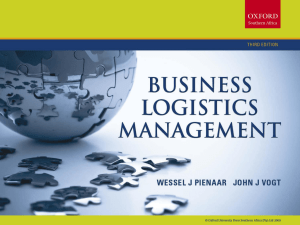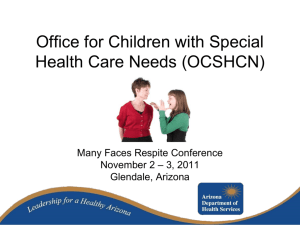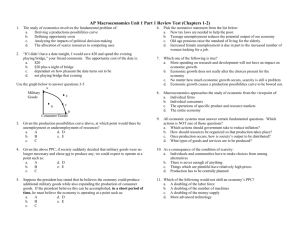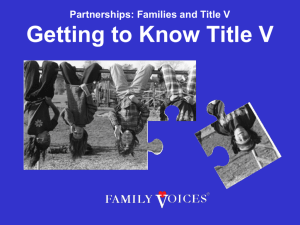history_of_ppc_12-09
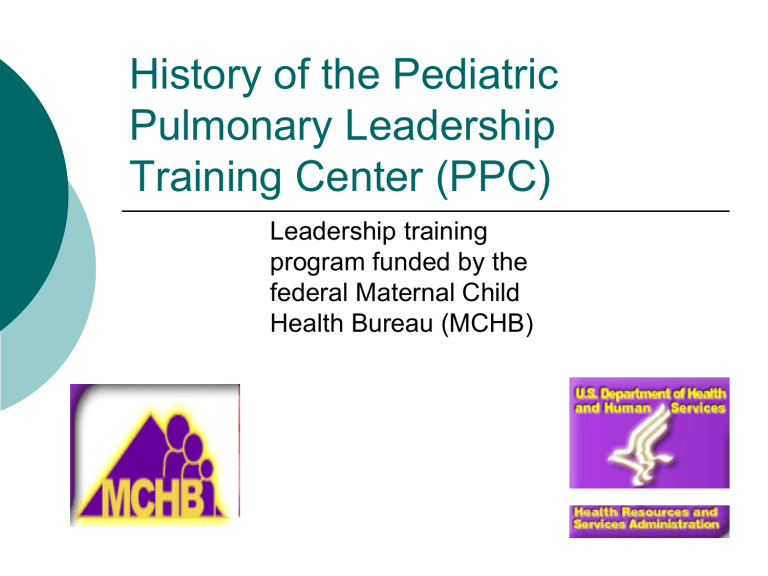
History of the Pediatric
Pulmonary Leadership
Training Center (PPC)
Leadership training program funded by the federal Maternal Child
Health Bureau (MCHB)
How did this training originate?
With this presentation, you will see how the federal government & federal agencies collaborate to provide funding to help with your training in your state and region & what they expect out of you!
2
Executive Branch
President of the United States
Health and Human Services (HHS)
Health Resources and Services Administration
(HRSA)
Maternal Child Health Bureau
(MCHB)
Division of Research, Training, Education (DRTE)
Pediatric Pulmonary Centers (PPC) 3
What does this mean to you as a PPC trainee?
Your training program in
MCHB is supported by several other federal agencies:
The Dept of Health and Human
Services (HHS)
Health Resources and Services
Administration (HRSA)
4
How do these agencies affect the
PPC training program?
We hope that if you understand how these agencies and programs originated and evolved at different times in the history of our country
you will better understand their purpose and your role
now and in the future
5
Department of Health and Human
Services (HHS)
Is one of 15 Departments in the
United States Executive Branch
protects the health of all
Americans
It is comprised of the Office of the
Secretary and 11 operating divisions.
http://www.hhs.gov/
Includes more than 300 programs
6
What is the purpose of Health &
Human Services (
HHS
)
The Department of Health and Human
Services provides essential human services, especially for those who are least able to help themselves.
Administers Health Resources and
Services Administration (HRSA) http://www.hrsa.gov/ is one of the Agencies of the Department of HHS and is the primary federal agency for improving access to health care services for people who are uninsured, isolated or medically vulnerable
7
Health Resources and Services
Administration (HRSA)
Contains six bureaus and 12 offices
Provides leadership and financial support to health care providers in US
HRSA grantees, such as PPCs, provide health care to uninsured people, and pregnant women, mothers and children
Trains health professionals
Works to improve systems of care in rural communities
Houses Maternal Child Health Bureau
(MCHB), which is where you come into the picture
8
Maternal Child Health Bureau
Oversees the Division of Research Training and Education
(DRTE), which is one of five divisions of the Health Resources and Services Administration's Maternal and Child Health
Bureau
Division of
Research
Training and Education
9
DRTE supervises PPCs
MCHB funds 15 categories of training for graduate and post graduate trainees
Emphasis on interdisciplinary training programs to improve health of mothers, children and families
PPCs are one of these 15 categories for training professionals
10
MCHB funds the Pediatric
Pulmonary Centers
Provide funds to work with a wide range of public and private agencies at both state and local levels
Train professionals to conduct research, develop standards, increase capacity for assessment, planning and assurance of quality of public health systems by:
improving health infrastructure eliminating health barriers
addressing disparities to health care
11
Before we go further, let’s go back to see how women and children’s health care was first brought to our nation’s attention.
12
How did children’s health first become important?
The US Public Health
Service originated in 1798; reorganized several times to become the Public
Health Service in 1912.
The federal Children’s
Bureau was first formed in
1912 to address child abuse and recognized that children’s health needed protection
The Maternity and Infancy
Care Act: aka Sheppard
Towner Act of 1921, started the process of providing federal grants to states to improve child health status.
13
When did Maternal Child Health first become important to this country?
With roots from the 1912
Children’s Bureau,
MCHB was one of the first agencies to recognize the importance of children’s health
This 1939 poster celebrated the efforts of the Children's Bureau, which is the federal agency responsible for the health and welfare of America's children. Source: SSA History Archives.
Primary job now is to improve the health of children, mothers and families.
14
But, the focus changed slowly from child abuse to health promotion
In 1935, Title V of the
Social Security Act was passed and signed by President
Roosevelt. Title V programs provide:
Grant funding for public and non-profit institutions of higher learning to train future professionals
Initially provided funds to improve health care of mothers and children
Later, was broadened to include families
15
How does Title V of 1935 affect the present needs of our country?
First, Let’s understand what is Title V?
Title V of Social Security Act (1935) is the longest lasting public health legislation in US History
It provides funding to accomplish the goals of the legislation & was not just a great idea without money to carry out goals
Many public and private agencies still get a portion of their funding through Title V
16
What is the strategy behind Title V implementation?
Emphasis then and now on developing leaders in the field of maternal child health; training professionals to help train others so the cycle can repeat
Includes all the health professions that work in maternal child health field
Retrieved from: http://www.provena.org/stjoes/body.cfm?id=602&oTopID=201
17
Title V & MCHB Funding are interdependent
Congress appropriates a budget for Title V:
MCHB budget determined by preset formulas
Funds are distributed to all
50 states & 9 jurisdictions in the
US in the form of
“block grants”
Funds are based on that state’s population and # of children in poverty
From US Census Bureau
18
So, what are State “Block
Grants?”
Block grants in each state use funds:
For low income pregnant women and children in the state
As part of federal matching program: every $4.00 of federal money matched by $3.00 from the state
Block grants are a fixed amount; these federal grants are sent to state and local governments to design and implement specific programs. at least > 30% of the funds for primary/preventative care & CSHCN, <
10% administrative costs.
19
Title V funding helps PPCs
•PPCs also collaborate with the state Block
Grants as both derive funding from MCHB
•A portion of federal Title V funds are set aside for
“discretionary” grants for “special projects of regional and national significance” (SPRANS)
•The PPCs are funded as a SPRANS grants, from Title V money
20
PPCs: Special Project of Regional and
National Significance
The PPC SPRANS grants are awarded on a competitive basis
Institutions of higher learning, such as Universities, write their grant proposals delineating:
how they would implement the goals of MCHB with children and families with chronic respiratory problems in their state
and the neighboring states in their region (see next slide for MCHB regions).
21
The MCHB Regions I-X
22
PPCs; an interdisciplinary pilot
PPCs came into existence in 1967 when the federal government, Division of Chronic Diseases and National
Regional Medical Program, funded 13 centers in the country that applied and were awarded the PPC grant funding for 1 year at a time
Interdisciplinary teams in each PPC were formed comprised of physicians, nurses, and social workers to provide specialized care to infants with respiratory conditions
After 1973, both respiratory therapists & dietitians joined the team
23
Historical Perspectives
An interview with Dave Woodrum, MD
Original Project Investigator, 1971
University of WA, Seattle, WA
24
As vulnerable children survived, a new strategy was needed
In 1973, MCHB assumed oversight/support of PPCs
Focus of all disciplines was changed from providing specialized care to infants to addressing comprehensive, coordinated care of children with both chronic and acute conditions
PPC faculty members provided training to graduate students from
University affiliated schools in Medicine,
Social Work, Nutrition,
Nursing and Respiratory
Care.
25
PPC Impact Broadens
The Omnibus Budget Reconciliation Act
(OBRA) of 1981 initiated the Maternal Child
Health Services “Block Grant”
PPC grant’s competitive renewal changed to every 5 years from annual renewals
Comprehensive care was defined as all inclusive, from tertiary care to community based care
Regional linkages with other Title V agencies and collaborative research was emphasized
In 1986, Crippled Children’s Services became Children with Special Health Care
Needs (CSHCN), which included the population of children served by PPCs
26
PPC goals have evolved over time due to public health needs
Promote comprehensive, coordinated, family centered and culturally sensitive systems of health care that serve the diverse needs of families in their communities and region
Mission is to develop interdisciplinary leaders who will improve health of children with respiratory conditions through family centered care.
27
Strategic Plan for Implementation in
PPC Training by MCHB
Between 1998-2004, MCHB developed a strategic plan for leadership training in all their categories of funded grants.
Categories include:
Maternal and Child Health Research &
Training (PPCs are part of the Training category), Adolescent Health, Education,
Genetic Services, Healthy Start, Infant and
Child Health, Emergency Medical Services,
Integrated Services, Perinatal and Women’s
Health.
28
MCHB Strategic Plan Goals
Assure national leadership
Improve the health infrastructure and systems of care for children to attain necessary quality care
Eliminate barriers and disparities of health care to children and families
Assure quality health care through timely research that is translated into practice to improve health outcomes
Assure the leadership training of a multidisciplinary, culturally diverse work force
Improve practice through interdisciplinary training in the PPCs
29
Currently, there are 6 University affiliated PPCs
Faculty on PPC grants at
Universities:
• train students at masters, doctoral or postdoctoral level in all disciplines
• promote MCHB values through inclusion in both practicum and curriculum
30
University-based PPCs
Currently:
University of Alabama at Birmingham-
Birmingham
University of Arizona-Tucson
University of Florida-Gainesville
University of New Mexico- Albuquerque
University of Washington-Seattle
University of Wisconsin-Madison
31
MCHB & PPC Current Goals and
Strategies
Emphasis on collaboration with Title V funded agencies, such as Public Health
Departments
Collaboration with all public and private agencies that provide health care for children
Perform & disseminate research & new knowledge to improve health outcomes and systems of care for CSHCN
This is graphically presented in the
MCHB Pyramid (next slide)
32
MCHB Pyramid
Describes the four levels of core public health services for the MCH population
Direct Health Care
Services:
Health Services for
CSHCN
Enabling Services: Examples:
Transportation, Translation, Outreach,
Respite Care, Health Education, Family
Support Services, Case Management
Framework for understanding programmatic direction and resource allocation by MCHB
POPULATION-BASED SERVICES
Examples: Newborn Screening, Lead Screening,
Immunization, Sudden Infant Death Syndrome
Counseling, Oral Health, Injury Prevention
Infrastructure Building Services:
Examples: Needs Assessment, Evaluation, Planning, Policy Development,
Coordination, Quality Assurance, Standards Development, Monitoring,
Training, Applied Research, Systems of Care, and Information Systems
33
Populations we serve; Children with
Special Health Care Needs (CSHCN):
So, who are the children and families served by the PPC grants?
Children who have chronic pulmonary conditions
Utilized as a model for teaching how to care for children with chronic conditions and their families
34
Children with Special Health Care
Needs (CSHCN)
CSHCN are defined as: Children who have or are at increased risk for chronic physical, developmental, behavioral or emotional conditions and who also require health and related services of a type or amount beyond that required by children generally. (MCHB, 1998).
35
Children with Special Health Care
Needs (CSHCN) specifically have:
Ongoing physical, emotional, behavioral or developmental condition that lasts longer than 12 months and
Requires continuing treatments, medications, personal assistance, medical equipment or devices
36
PPC training to serve CSHCN is multifaceted
A unique opportunity for graduate professional training
Each faculty/discipline on PPC grant selects long, medium and short term trainees, involving them in interdisciplinary leadership activities through training and mentorship
Provide consultation and technical assistance to children’s systems in the region, while collaborating with other Title V funded agencies who also serve CSHCN
37
Activity of PPCs
Develop systems to reduce disparities and access to care
Promote a “medical home” to maintain community based care for the family;
Promote collaboration with specialty and primary care providers and services
38
Collaboration with Title V Agencies serves CSHCN
PPCs also collaborate with other MCHB funded programs, some of which may include :
Bright Futures, Healthy Start, Children’s
Emergency Services, LEND grants, LEAH grants, Schools of Public Health, Unidisciplinary grants such as in Dentistry, & Public Health
Departments
39
PPC Training Programs Emphasize:
Comprehensive & Community based Family
Centered, Culturally Competent care
Advocacy activities to accomplish goals
Policy Development that impact systems of care for CSHCN and their families
How do you define “community”?
40
Defining the Community of a Child and
Family
Involves planning care in all settings and systems that interact with child and family: specialty and primary health care, daycare, schools, & home.
Strategic care can take place in
Classrooms and schools
Medical or community practice settings
Child’s home, relative’s home, play/sport venues
41
So, how do we know if this training program is effective?
We ask former trainees to stay in touch with us
We ask their opinion after their training
We ask them to tell us of their accomplishments and work
Outcome of PPC Training Program
The first long term follow up survey and description of professional work performed by past trainees in the
PPC was conducted in 1998.
77.3% in child health field with CSHCN
82%/18% Work/developed interdisciplinary team
48% Program eval/strategic planning-CHSCN
68% Development of guidelines for CSHCN
92% Teaching
Post training program, all trainees are followed annually and questioned about their leadership activities, professional development and job responsibilities.
Currently, trainees are queried every 1, 5 & 10 years
43
Performance Measures are now part of all programmatic evaluations
Performance Measures were initiated in
2003 to assess faculty and trainee progression toward MCHB goals
Several Performance Measures are tracked by MCHB for all their funded grants
PPCs are continuing to develop additional measures to evaluate unique aspects of our training program
44
PPC Specific Performance
Measures
Performance Measures that specifically evaluated post-training professional activities of former trainees revealed in 2007:
95.5% of MCHB long term trainees demonstrate field leadership 5 years after finishing
Trainees working in an interdisciplinary setting with
MCHB population after 1 year: 92%, after 5 years
75%, after 10 years 82.6%
45
Collaborative and/or Individual Center’s
Accomplishments
Host of Regional Asthma Summits
Asthma guidelines for schools
Outreach clinics to underserved areas of region and state
American Thoracic Guidelines: Care of the
Child with a Chronic Tracheostomy publication
American Dietetic Association publication:
Chronic Pulmonary Conditions in Children-
Case Studies for Nutrition
Maternal & Child Health Journal Publication:
Interdisciplinary Leadership Training
Outcomes
46
Examples of PPC’s Collaborative
Work
Pediatric
Pulmonology.
Supplement:
Guidelines for
Care of Children with Chronic Lung
Disease
Cultural Competency
Training Modules
Advocacy Curriculum for Trainees
ADVOCACY CURRICULUM
PEDIATRIC
PULMONARY
CENTER TRAINING
GRANT
MATERNAL CHILD
HEALTH BUREAU
HEALTH RESOURCES
AND SERVICES
ADMINISTRATION
47
Pediatric Pulmonary Centers
For further information on all current
PPC centers: http://ppc.mchtraining.net/
Robyn Schulhof, MA
Project Officer
rschulhof@hrsa.gov
48
"The significant problems we face today cannot be solved at the same level of thinking we were at when we created them."
Albert Einstein
-
49
MCH History: Vince L. Hutchins
Pediatrician, public servant, champion of Title V, mentor
On leadership in troubling times: “You do the job you have to do and seize every opportunity to make a difference.”
Credit: Kay Johnson
50
